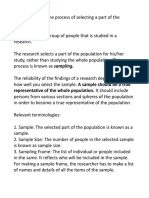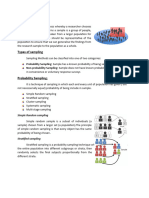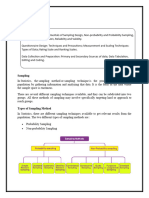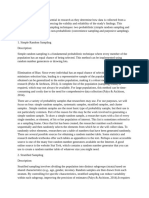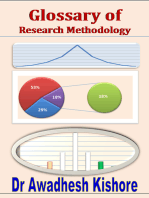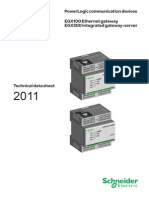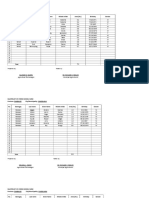Sampling BRM For
Uploaded by
22MBA320-KOLANCHIYAMMAL R MBASampling BRM For
Uploaded by
22MBA320-KOLANCHIYAMMAL R MBAIn business research, sampling refers to the process of selecting a subset of individuals or entities
from a larger population that is representative of the population as a whole. Sampling is an
essential aspect of research methodology as it allows researchers to gather data that is both
accurate and reliable, while also minimizing costs and time involved in data collection.
There are several sampling methods used in business research, including:
Probability Sampling: Probability sampling is a method that involves selecting individuals or
entities from a population using a random process. This ensures that every member of the
population has an equal chance of being selected, and that the sample is representative of the
population. Some common probability sampling methods include simple random sampling,
stratified random sampling, and cluster sampling.
Non-Probability Sampling: Non-probability sampling is a method that involves selecting
individuals or entities from a population using a non-random process. This means that some
members of the population may have a higher chance of being selected than others, which can
affect the representativeness of the sample. Some common non-probability sampling methods
include convenience sampling, purposive sampling, and snowball sampling.
Quota Sampling: Quota sampling is a method that involves selecting individuals or entities from
a population based on specific characteristics or quotas. For example, if a researcher wanted to
sample a population based on age and gender, they would set quotas for each group and select
individuals to meet those quotas.
Cluster Sampling: Cluster sampling is a method that involves selecting groups or clusters of
individuals or entities from a population, rather than selecting individual members. This method
is often used when the population is geographically dispersed, and it can be more cost-effective
than other sampling methods.
In conclusion, sampling is an important aspect of business research, and researchers must
carefully consider the sampling method that best fits their research objectives, population size,
and available resources. By selecting a representative sample, researchers can gather data that
accurately reflects the population, which can lead to more accurate and reliable research
findings.
Types of probability sampling
Simple Random Sampling: Simple random sampling is a basic probability sampling method
where each member of the population has an equal chance of being selected for the sample. This
method involves selecting individuals randomly from the population without any bias, making it
an unbiased method of sampling.
Systematic Sampling: Systematic sampling is a probability sampling method where the
researcher selects a random starting point from the population and then selects every nth
individual from the population to be included in the sample. This method is useful when the
population is too large to select individuals randomly.
Stratified Sampling: Stratified sampling is a probability sampling method where the population is
divided into homogeneous subgroups or strata based on a characteristic of interest. Then, a
simple random sample is drawn from each stratum. This method ensures that the sample is
representative of the entire population.
Cluster Sampling: Cluster sampling is a probability sampling method where the population is
divided into clusters, and a random sample of clusters is selected. The researcher then collects
data from all members of the selected clusters. This method is useful when the population is
dispersed geographically.
Types of non-probability sampling
Convenience Sampling: Convenience sampling is a non-probability sampling method where the
researcher selects individuals who are most easily accessible or convenient to the researcher.
This method is often used when time and resources are limited.
Purposive Sampling: Purposive sampling is a non-probability sampling method where the
researcher selects individuals based on specific characteristics that are important to the research.
This method is useful when the researcher wants to target a specific population or subgroup.
Quota Sampling: Quota sampling is a non-probability sampling method where the researcher
selects individuals based on pre-determined quotas for certain characteristics, such as age,
gender, or race. This method is useful when the researcher wants to ensure that the sample is
representative of certain characteristics of the population.
Snowball Sampling: Snowball sampling is a non-probability sampling method where the
researcher initially selects a small group of individuals who meet the criteria for the study, and
then asks them to refer other individuals who meet the criteria. This method is useful when the
population is hard to access or identify.
The following are the general steps involved in sampling in research:
Define the Population: The first step in sampling is to define the population of interest. The
population should be clearly defined based on the research question or problem.
Determine the Sampling Frame: The sampling frame is a list of all individuals or units in the
population from which the sample will be drawn. The sampling frame should be accurate, up-to-
date, and accessible.
Choose the Sampling Method: The sampling method should be selected based on the research
question, available resources, and level of accuracy required. Probability sampling methods, such
as simple random sampling, systematic sampling, stratified sampling, and cluster sampling, are
commonly used in research.
Determine the Sample Size: The sample size should be determined based on the research
question, population size, desired level of accuracy, and available resources. The larger the
sample size, the more representative the sample will be of the population.
Select the Sample: Once the sampling method and sample size are determined, the sample can be
selected. The sample should be selected using the chosen sampling method and should be
representative of the population.
Collect Data from the Sample: Data can be collected from the sample using various data
collection methods, such as surveys, interviews, observations, and secondary data sources.
Analyze the Data: The data collected from the sample should be analyzed using appropriate
statistical methods. The results can be used to draw conclusions and make inferences about the
population.
Here are some key questions that should be asked when designing a sampling strategy:
What is the research question or problem?
The research question or problem should be clearly defined to determine the population of
interest.
Who is the population of interest?
The population should be defined based on the research question or problem.
What is the sampling frame?
The sampling frame is a list of all individuals or units in the population from which the sample
will be drawn. It should be accurate, up-to-date, and accessible.
What is the sampling method?
The sampling method should be chosen based on the research question, available resources, and
level of accuracy required.
What is the sample size?
The sample size should be determined based on the research question, population size, desired
level of accuracy, and available resources.
What is the sampling interval or selection criteria?
The sampling interval or selection criteria should be determined based on the chosen sampling
method.
What is the level of precision or confidence desired?
The level of precision or confidence desired should be determined based on the research question
and available resources.
What is the margin of error?
The margin of error should be determined based on the sample size and level of precision
desired.
What is the response rate?
The response rate is the percentage of individuals or units that respond to the survey or
questionnaire.
What are the ethical considerations?
Ethical considerations should be taken into account when selecting the sample and collecting
data from the sample.
Advantages of Sampling:
Cost-effective: Sampling is generally less expensive and time-consuming than collecting data
from the entire population. This is because it requires fewer resources, such as manpower,
materials, and finances.
Time-saving: Sampling enables researchers to collect data within a shorter period of time, as it
only involves a subset of the population.
Convenience: Sampling is more convenient than collecting data from the entire population, as it
requires less effort and resources.
Accuracy: Sampling can be as accurate as collecting data from the entire population if the
sample is representative of the population and the sample size is sufficient.
Disadvantages of Sampling:
Sampling error: Sampling error occurs when the sample is not representative of the population or
the sample size is too small. This can result in biased or inaccurate results.
Bias: Sampling bias occurs when the sample is not randomly selected or is not representative of
the population. This can result in inaccurate or skewed results.
Difficulty in selecting an appropriate sample: It can be challenging to select an appropriate
sample that is representative of the population, especially when the population is large and
diverse.
Generalizability: The results obtained from a sample may not be generalizable to the entire
population. This is because the sample is only a subset of the population, and there may be
differences between the sample and the population.
You might also like
- Stock Watson 3u Exercise Solutions Chapter 13 InstructorsNo ratings yetStock Watson 3u Exercise Solutions Chapter 13 Instructors15 pages
- 18MBC24 Business Research Methods Notes For Test II Qualitative Data Collection MethodsNo ratings yet18MBC24 Business Research Methods Notes For Test II Qualitative Data Collection Methods35 pages
- What Is Sampling?: Sampling Definition: Sampling Is A Technique of Selecting IndividualNo ratings yetWhat Is Sampling?: Sampling Definition: Sampling Is A Technique of Selecting Individual6 pages
- Research - Sampling Methods and TechniquesNo ratings yetResearch - Sampling Methods and Techniques7 pages
- Types of Sampling Sampling Methods With Examples QuestionProNo ratings yetTypes of Sampling Sampling Methods With Examples QuestionPro1 page
- BIO 310 RESEARCH METH. BY ADENIYI K. A. 2No ratings yetBIO 310 RESEARCH METH. BY ADENIYI K. A. 217 pages
- Marketing Assingment: Submitted By: Mohammed Mudassir Submitted To: Prof. Harsha MamNo ratings yetMarketing Assingment: Submitted By: Mohammed Mudassir Submitted To: Prof. Harsha Mam18 pages
- Lesson 7:: Population and Sampling MethodsNo ratings yetLesson 7:: Population and Sampling Methods58 pages
- Subject: Quantitative Techniques PGDM 2nd Trimester Topic: Sampling Techniques Submitted To: Sowmya MamNo ratings yetSubject: Quantitative Techniques PGDM 2nd Trimester Topic: Sampling Techniques Submitted To: Sowmya Mam8 pages
- Sampling Techniques in Reserarch MethodolgyNo ratings yetSampling Techniques in Reserarch Methodolgy10 pages
- Sampling in Quantitative Studies: Basic Sampling Concepts 1. PopulationNo ratings yetSampling in Quantitative Studies: Basic Sampling Concepts 1. Population11 pages
- PDF A Project On Marketing Strategy of Big BazaarNo ratings yetPDF A Project On Marketing Strategy of Big Bazaar18 pages
- Guy Wire Hardware For Set # 1 at Elev 75.00 FTNo ratings yetGuy Wire Hardware For Set # 1 at Elev 75.00 FT1 page
- Reverting To The Default Factory Configuration For The EX Series Switch - Technical Documentation - Support - Juniper NetworksNo ratings yetReverting To The Default Factory Configuration For The EX Series Switch - Technical Documentation - Support - Juniper Networks2 pages
- Integration of Git Java and Maven To JenkinsNo ratings yetIntegration of Git Java and Maven To Jenkins2 pages
- Supply Chain Management: by Tauseef Iqbal KhanNo ratings yetSupply Chain Management: by Tauseef Iqbal Khan22 pages
- Candelaria MASTERLIST of Hybrid Model Farm (Per Cluster)No ratings yetCandelaria MASTERLIST of Hybrid Model Farm (Per Cluster)5 pages
- Bagaimanakah Beban Kerja Dan Stres Kerja Mempengaruhi Kinerja Karyawan Dengan Burnout Sebagai Variabel MediasiNo ratings yetBagaimanakah Beban Kerja Dan Stres Kerja Mempengaruhi Kinerja Karyawan Dengan Burnout Sebagai Variabel Mediasi14 pages
- Biostatistics - Mean of Continuous SeriesNo ratings yetBiostatistics - Mean of Continuous Series5 pages
- Conquilla vs. Bernardo, A.M. No. MTJ-09-1737, February 9, 2011No ratings yetConquilla vs. Bernardo, A.M. No. MTJ-09-1737, February 9, 20115 pages
- He Who Has Never Learned To Obey Cannot Be A GoodNo ratings yetHe Who Has Never Learned To Obey Cannot Be A Good4 pages
- Detection Systems For Reducing The Risk of Hydrogen Fires - Chemical Engineering - Page 3No ratings yetDetection Systems For Reducing The Risk of Hydrogen Fires - Chemical Engineering - Page 34 pages
- What Is Fact?: A Fact Is A Collection of Related Data Items, Each Fact Typically Represents A Business Item, ANo ratings yetWhat Is Fact?: A Fact Is A Collection of Related Data Items, Each Fact Typically Represents A Business Item, A28 pages
- ELYM 115 2nd Opp Examination MC-2022-09-21 TTNo ratings yetELYM 115 2nd Opp Examination MC-2022-09-21 TT3 pages
- Stock Watson 3u Exercise Solutions Chapter 13 InstructorsStock Watson 3u Exercise Solutions Chapter 13 Instructors
- 18MBC24 Business Research Methods Notes For Test II Qualitative Data Collection Methods18MBC24 Business Research Methods Notes For Test II Qualitative Data Collection Methods
- What Is Sampling?: Sampling Definition: Sampling Is A Technique of Selecting IndividualWhat Is Sampling?: Sampling Definition: Sampling Is A Technique of Selecting Individual
- Types of Sampling Sampling Methods With Examples QuestionProTypes of Sampling Sampling Methods With Examples QuestionPro
- Marketing Assingment: Submitted By: Mohammed Mudassir Submitted To: Prof. Harsha MamMarketing Assingment: Submitted By: Mohammed Mudassir Submitted To: Prof. Harsha Mam
- Subject: Quantitative Techniques PGDM 2nd Trimester Topic: Sampling Techniques Submitted To: Sowmya MamSubject: Quantitative Techniques PGDM 2nd Trimester Topic: Sampling Techniques Submitted To: Sowmya Mam
- Sampling in Quantitative Studies: Basic Sampling Concepts 1. PopulationSampling in Quantitative Studies: Basic Sampling Concepts 1. Population
- Reverting To The Default Factory Configuration For The EX Series Switch - Technical Documentation - Support - Juniper NetworksReverting To The Default Factory Configuration For The EX Series Switch - Technical Documentation - Support - Juniper Networks
- Candelaria MASTERLIST of Hybrid Model Farm (Per Cluster)Candelaria MASTERLIST of Hybrid Model Farm (Per Cluster)
- Bagaimanakah Beban Kerja Dan Stres Kerja Mempengaruhi Kinerja Karyawan Dengan Burnout Sebagai Variabel MediasiBagaimanakah Beban Kerja Dan Stres Kerja Mempengaruhi Kinerja Karyawan Dengan Burnout Sebagai Variabel Mediasi
- Conquilla vs. Bernardo, A.M. No. MTJ-09-1737, February 9, 2011Conquilla vs. Bernardo, A.M. No. MTJ-09-1737, February 9, 2011
- Detection Systems For Reducing The Risk of Hydrogen Fires - Chemical Engineering - Page 3Detection Systems For Reducing The Risk of Hydrogen Fires - Chemical Engineering - Page 3
- What Is Fact?: A Fact Is A Collection of Related Data Items, Each Fact Typically Represents A Business Item, AWhat Is Fact?: A Fact Is A Collection of Related Data Items, Each Fact Typically Represents A Business Item, A


























